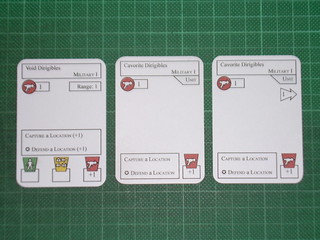In the early stages of making cards for a game I do the art on A3 sheets of paper, with the cards in a 5 x 5 grid. I've got a blank document ready in Adobe InDesign which already has all the document guides to line things up to and the cutting guides ready prepared on a separate layer.
Having the document with A3 print size is convenient for printing, and works fine at the beginning when the card count and mix is changing regularly, but once things start to settle down it is good to move to a new format.
For Carpe Astra and Sumeria I got the printing done by LudoFact one of Germany's big games printers. They want to receive the cards as a print quality PDF or PostScript file, with one card per page, each page the size of the cards themselves. So I had to make a document where the page size was 56mm x 87mm (a standard card size, apparently). This is actually pretty convenient for doing the rulebook too, as it's easy to place a page of another InDesign document as a graphic in a document, so I could place page 40 of the cards document to get a particular card for illustrating an example.

Switching to the smaller form factor too early makes thing awkward as you now have two documents to update before printing: Make the changes to the single cards document and then go to the A3 print document, update the links and delete pages and re-add them to make the changes to the card counts. But once the card balance is steady it's not bad at all. All you need to do is open the A3 print document, update the links to the modified single card-per-page document and then click print. In fact, in some ways it makes things slightly easier, as while working in the A3 print document I keep the cutting guides layer hidden so that I don't accidentally drag some of the cutting guides around with the card art. On at least two occasions I've forgotten to show the cutting guides again before printing, which means I need to either mark the guides on with pencil (a real arse when there's 36 of them per page and 14 pages) or print it again and waste loads of card. Having them separate means that I'll no longer be doing anything in the A3 document, so I can leave them permanently enabled.
Of course, seeing as I'm moving things around, I'm taking this chance to tweak a few of the cards again and do a little bit more layout/pictography improvement too. Barely a week goes by without me making some small changes to the game. Fortunately, I'm not thinking of backing out the bigger changes between my current version and the previous one - just improving the balance of some of the weaker sets of cards.
The next step after changing the size of the document and getting the print document to link to the new one is to do a proper rulebook. Initially the rulebook was just a set of notes for me. The current rulebook is a complete description of the (previous version of the) game (but without examples or any illustrations/clarification). I need to update the rulebook to the new rules and get it into a finished enough state that people can learn the game blind from it. Then I hope to send it to a couple of my previous gaming groups (which obviously requires making a couple of extra copies) and possibly to some of my far-flung Reiver Games playtesters (or I might wait for that until I've incorporated feedback from my ex-gaming chums).
The other advantage of the single-card per page version is that it allows me to set up an A4 print document that's easy to keep in sync as things change so that I can provide print-and-play copies to selected others (seeing as most people don't have an A3 printer).






